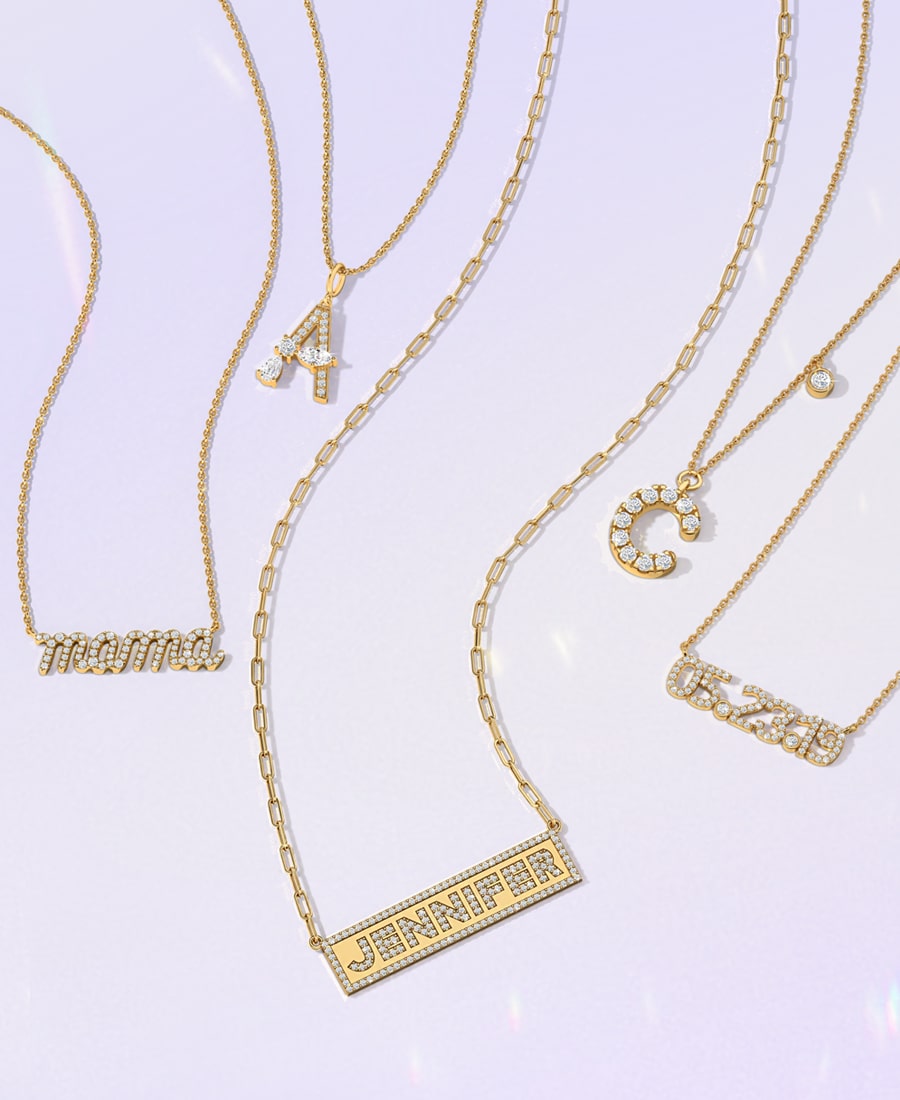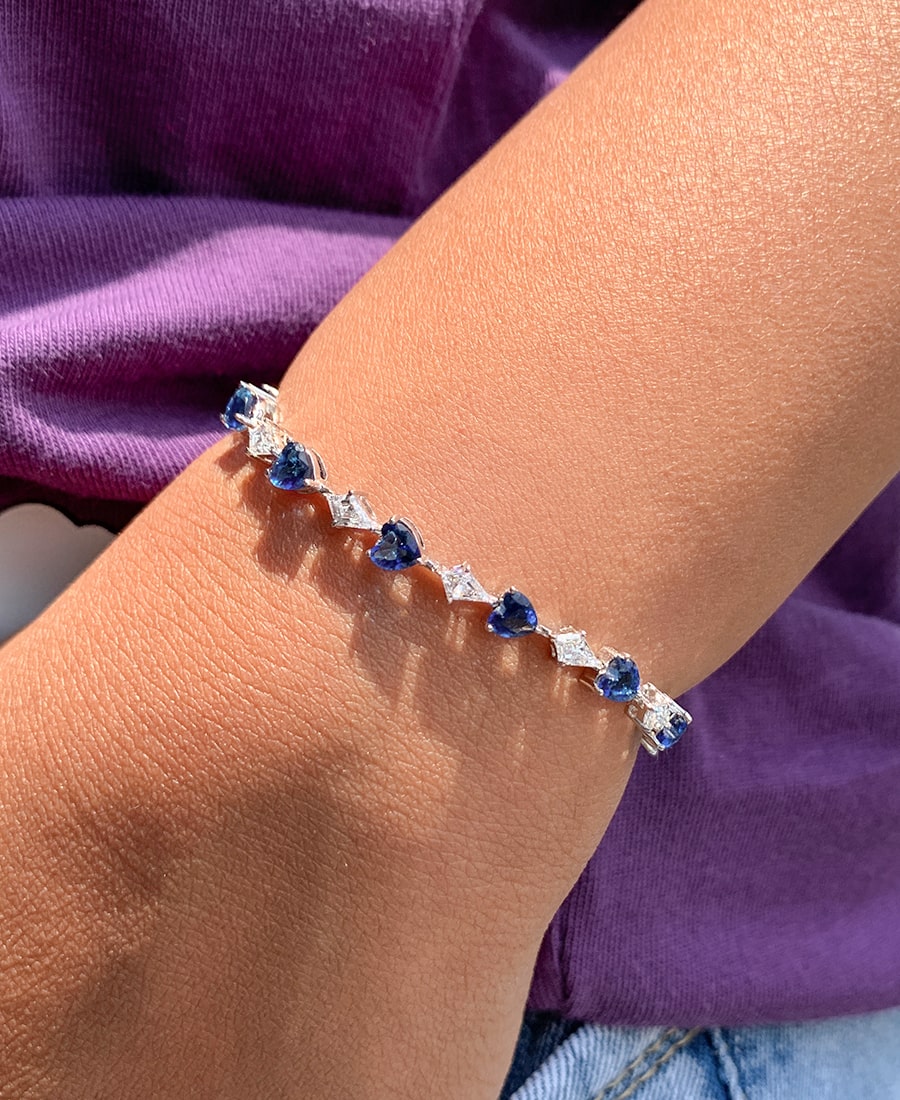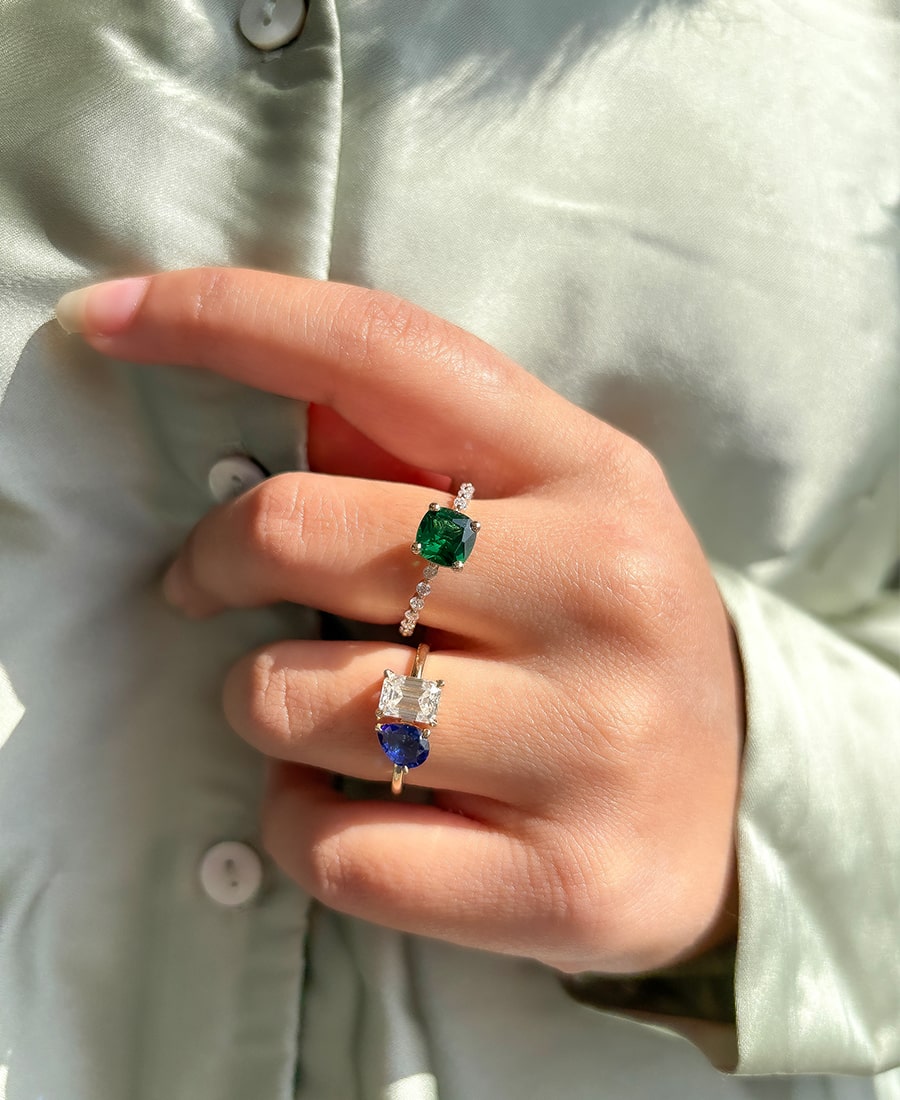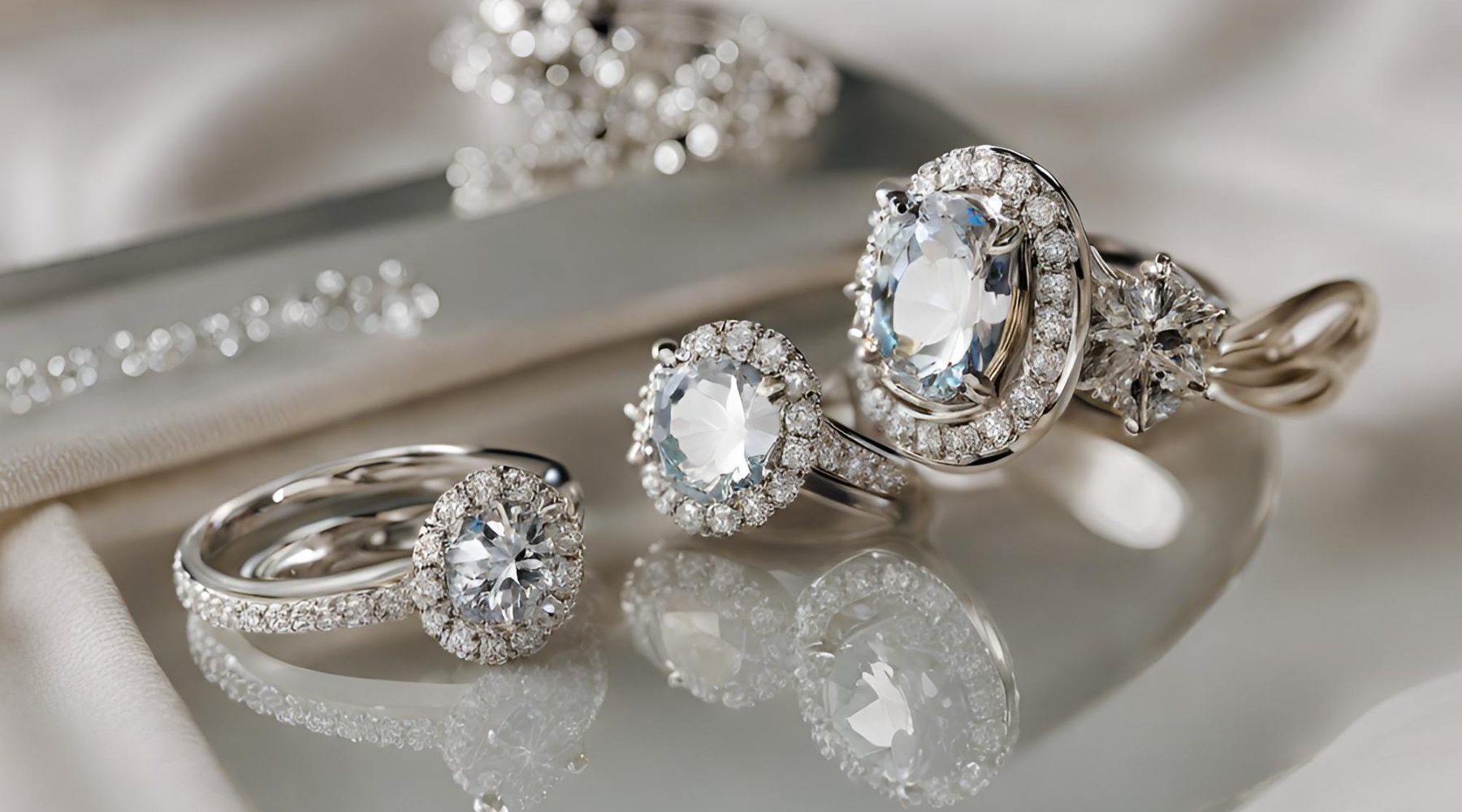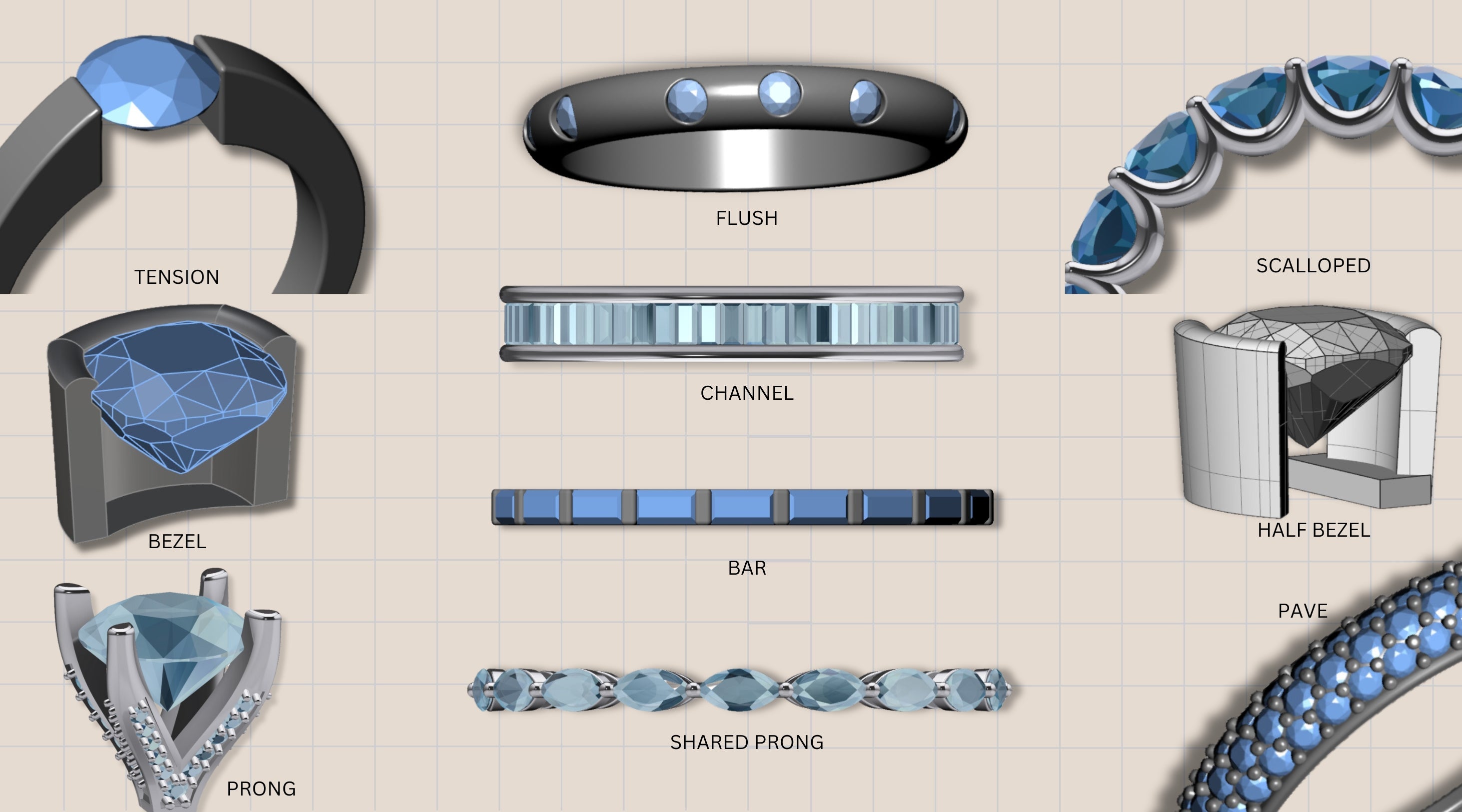
Different Types of Jewelry Settings
The jewelry settings have a large influence on how the particular piece of jewelry appears to be. It secures gemstones or diamonds and can transform the appearance of jewelry. There seem to be various types and numbers of settings. In fact, different settings have distinct characteristics and advantages. Here’s a brief overview of the most popular kinds of settings you might find on jewelry.
Key Takeaways
|
Top Jewelry Settings You Should Give a Try
Prong Setting

The prong setting is one of the most used or preferred settings. In this type, small metal claws are used to grasp the gemstone securely. Typically, the number of prongs ranges between four and six. This background best displays the gemstone because it is well-illuminated. It’s mostly applied in the creation of rings and earrings.
Benefits:
- Maximizes light and sparkle.
- Keeps the gemstone secure.
Considerations:
- Cutting edges can snag at articles of clothing.
- May require occasional quality checks to confirm that the prongs are well-fixed.
Shared Prong Setting

A shared prong setting, a variation of the prong setting, involves multiple diamonds sharing the same prongs, resulting in a continuous row seen in tennis bracelets or eternity rings. This setting can also form a halo around a center gemstone, as observed in halo rings or pendants.
|
Advantage 👍🏻 |
Disadvantage👎🏻 |
|
Creates a seamless and elegant appearance, minimizing metal visibility and emphasizing diamonds. |
Exposes gemstones to increased risk of damage over time, as shared prongs may weaken or break, leading to potential loss of gemstones. |
|
Enhances brilliance and fire by allowing more light to enter and reflect from the gemstones. |
Gemstones may be susceptible to scratches or chips from hard surfaces or impacts. |
|
Particularly suitable for small to medium-sized diamonds, including round, princess, and cushion shapes. |
Requires regular maintenance and cleaning to prevent dirt accumulation under gemstones and between prongs. |
Channel Setting

Channel setting requires the positioning of the stones into a groove or channel. Some of the stones touch each other, with no spaces being filled with metal. This setting is most often used in wedding bands or eternity rings.
Benefits:
- Characterized by ridges that offer a continuous and unbroken line along the surface of the stones.
- Helps in keeping stones safe and guarded.
Considerations:
- It is challenging to resize the band.
- These stones might be difficult to wash or to clean.
Bar Setting
In a bar setting, gemstones are held in place by vertical bars of metal. The bars separate the stones but keep them aligned in a row. This setting is often used in bracelets and earrings.
Benefits:
- Keeps stones secure and aligned.
- Allows for a modern and sleek design.
Considerations:
- Stones can be harder to clean between the bars.
- The setting might not be suitable for all gemstones.
Pave Setting
In the paved setting, numerous small stones are placed together with a minimum of space in between them. They are kept in position by small particles of the metal. The result is a face that has the appearance of resembling that of diamonds and shining brightly. This kind of setting is normally used in rings, bracelets, and earrings.
Benefits:
- It provides an unbroken, shimmering appearance.
- It is especially suitable for giving a touch of brilliance.
Considerations:
- Stones are quite small and can easily get misplaced whenever they are not well secured.
- It must be washed periodically so that its luminous surface can be retained.
Bezel Setting
The bezel setting has a metal rim that encircles the gemstone. It encloses the stone properly and provides significant protection. This setting is especially common with engagement rings and pendants.
Benefits:
- Provides the protection of the outer rims of the gemstone.
- They are least likely to catch things.
Considerations:
- It might help reduce the amount of light that gets to the gemstone.
- It can make the stone appear smaller.
Tension Setting

In a tension setting, the gemstone is held between two metal bands so that they give the impression of being suspended. These bands are adjusted in a manner that can create tension that holds the stone in position. This setting can be utilized for a modern and simple look.
Benefits:
- These have a sophisticated, contemporary look that is bound to catch the attention of customers and clients.
- Enables the most significant level of light transmission through the stone.
Considerations:
- Calls for careful design in terms of security engineering.
- Gemstones that cannot be measured or weighed accurately by volume should not be subjected to this method.
Half Bezel Setting

A half bezel setting, a variation of the bezel setting, involves the metal rim covering only a portion of the diamond's edge, leaving other parts exposed. This metal rim can extend across opposite sides, like the top and bottom, or adjacent sides, such as the left and right. It may also take on a shape that complements or contrasts with the lab-grown and moissanite diamonds, resulting in a distinctive appearance.
|
Advantage 👍🏻 |
Disadvantage👎🏻 |
|
Protects the diamonds from damage. |
Can make the diamonds look smaller or asymmetrical |
|
Allows more light to enter and reflect from the diamonds. |
Requires more skill and precision to create. |
Flush/Gypsy Setting

Another type of prong setting is the flush setting or gypsy setting. It is a setting technique in which the stones are set to be level with the surface of the metal. The stones are placed into the metal cladding in such a way that they are flush with the band. This setting is often found in men’s rings or other contemporary jewelry.
Benefits:
- Stones are well-protected and won’t catch on things.
- Gives a simple but elegant appearance.
Considerations:
- Stones might look less shiny, or there would be less sparkle in them.
- Need to have perfect workmanship to guarantee the stones are well placed in position.
Scallop/Fishtail Setting

The scallop or fishtail setting, a variation of pave, features metal beads or prongs shaped like scallops or fishtails, creating a decorative look. These can be adorned with accent stones for added sparkle.
Advantage:
- Enhanced Aesthetics: Adds detail and texture, achieving a beautiful, elegant look.
- Increased Brilliance: Allows more light, enhancing brightness and fire.
- Versatility: Ideal for small gemstones, especially in round, princess, and marquise shapes
Disadvantage:
- Risk of Damage: Metal elements may wear off or break, risking gemstone loss.
- Susceptibility to Scratches: Gemstones can get scratched or chipped.
- Skill and Precision Requirement: Crafting demands high skill and precision.
|
Setting Type |
Description |
|
Prong Setting |
Uses small claws to hold gems. |
|
Bezel Setting |
Wraps metal around the gem. |
|
Channel Setting |
Gems sit in a row, held by metal. |
|
Pave Setting |
Tiny gems cover the surface. |
|
Tension Setting |
Gem held by pushing metal. |
|
Invisible Setting |
Gems fit into hidden slots. |
|
Halo Setting |
A central gem surrounded by smaller gems. |
|
Bar Setting |
Gems held by metal bars. |
Conclusion
Choosing the right setting makes your jewelry look great and last longer. Each setting has its own style and benefits. Knowing these helps you pick the best jewelry for you.
FAQs
1. What is the difference between pave and micro-pave?
"Pave" and "micro-pave" are terms in jewelry settings. Pave has larger stones set closely with minimal metal, while micro-pave uses even smaller stones with barely visible metal, creating a more intricate setting. Micro-pave is essentially a refined version of pave.
2. How do I choose a jewelry setting for my gemstone?
When choosing a jewelry setting for your gemstone, consider type, durability, style, metal, and security to align with your preferences and gemstone characteristics.
3. What is the difference between a pave and a fishtail setting?
The key difference between a pave and fishtail setting is in their arrangement of small gemstones. Pave sets stones closely for a continuous sparkle, while fishtail arranges them in a fish-tail-like pattern for a distinctive look in jewelry.
4. Which gemstones are suitable for flush or gypsy settings?
Select durable gemstones like diamonds, rubies, and sapphires for flush or gypsy settings to enhance the design and ensure long-lasting quality.

